Weekly Current Affairs (8th to 14th February 2023) Part - 2 | General Test Preparation for CUET UG - CUET Commerce PDF Download
Multilateral Security Dialogue on Afghanistan
Context: Recently, the National Security Advisor(NSG) addressed a Multilateral Security Dialogue on Afghanistan in Moscow.
- The discussion revolved around issues related to Afghanistan, including security and humanitarian challenges and was attended by representatives from various countries including Russia, China, and Iran.
What are Key Highlights of the Dialogue?
- NSG emphasized that no country should be allowed to use Afghan territory for exporting terrorism and that India will always support the people of Afghanistan in their time of need.
- NSG also spoke about the importance of UN Security Council resolution 2593 that calls for denying sanctuary to terror outfits in the region.
How is India’s Relations with Afghanistan?
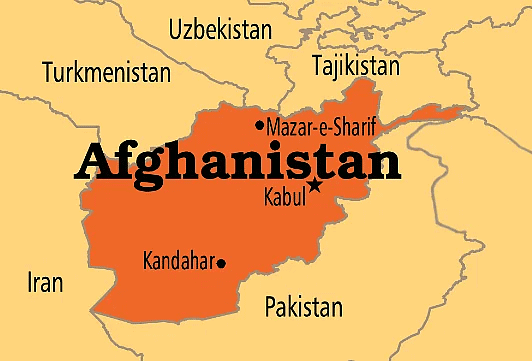 About:
About:
- India and Afghanistan have had close historical, cultural, and economic ties for centuries.
- The relationship between the two countries has undergone significant changes in the post-9/11 era, with India playing an increasingly active role in the reconstruction and development of Afghanistan.
Political Relations:
- India has been a strong supporter of Afghan democracy and has consistently advocated for a stable, peaceful, and prosperous Afghanistan.
- But India is still yet to recognize the Taliban regime in Afghanistan and has been advocating for the formation of an inclusive government in Kabul.
- Also, India re-established its diplomatic presence in Kabul in June 2022.
Humanitarian Assistance:
- India has been providing humanitarian aid to Afghanistan, including 40,000 metric tonnes of wheat, 60 tonnes of medicines, 5,00,000 Covid vaccines, winter clothing, and 28 tonnes of disaster relief.
- India has also granted scholarships to 2,260 Afghan students, including 300 girls, over the past two years.
Economic Relations:
- India has undertaken more than 400 key infrastructure projects in all 34 Afghan provinces and has signed strategic agreements to enhance trade and bilateral relations.
- From 2002 to 2021, India spent USD 4 billion in development assistance in Afghanistan, building high-visibility projects such as highways, hospitals, the parliament building, rural schools, and electricity transmission lines.
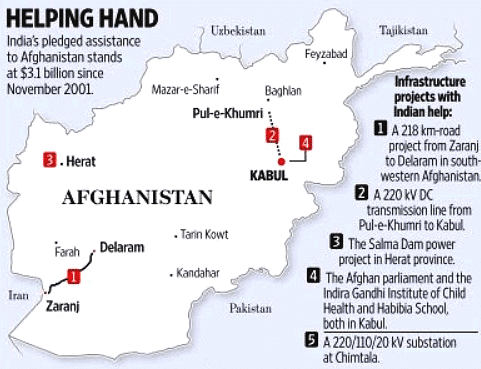 Connectivity:
Connectivity:
- India has been working towards building regional connectivity with Afghanistan by developing the Chabahar port and providing access to markets in the region.
What is the Significance of Afghanistan for India?
Geopolitical Location
- Afghanistan is located at the crossroads of Central and South Asia, and its stability and security have a direct impact on India's interests in the region.
- Afghanistan serves as a bridge between South and Central Asia and is critical for India's pursuit of regional connectivity and economic integration.
Countering Terrorism:
- Afghanistan has been a hotbed of terrorism, with various terrorist groups operating from its territory.
- India has a direct interest in ensuring that Afghanistan does not become a safe haven for terrorists who threaten its security.
Strategic Interests:
- Afghanistan is important to India's strategic interests as it is located at the heart of the historic Silk Road.
- India's presence in Afghanistan helps to counterbalance the influence of Pakistan and China in the region.
Primary Agricultural Credit Societies
Context: Recently, the Union Budget 2023 has announced Rs 2,516 crore for digitization of 63,000 Primary Agricultural Credit Societies (PACS) over the next five years.
What is the Aim of Digitizing PACS?
- It aims at bringing greater transparency and accountability in their operations and enabling them to diversify their business and undertake more activities.
- It aims to help PACS become a nodal centre for providing various services such as Direct Benefit Transfer (DBT), Interest Subvention Scheme (ISS), Crop Insurance Scheme (PMFBY), and inputs like fertilizers and seeds.
What is Primary Agricultural Credit Societies?
About:
- PACS are village level cooperative credit societies that serve as the last link in a three-tier cooperative credit structure headed by the State Cooperative Banks (SCB) at the state level.
- Credit from the SCBs is transferred to the District Central Cooperative Banks (DCCBs), that operate at the district level. The DCCBs work with PACS, which deal directly with farmers.
- PACSs provide short-term, and medium-term agricultural loans to the farmers for the various agricultural and farming activities.
- The first PACS was formed in 1904.
 Status:
Status:
- A report published by the Reserve Bank of India on December 27, 2022 put the number of PACS at 1.02 lakh. At the end of March 2021, only 47,297 of them were in profit.
What is the Significance of PACS?
- Access to Credit: PACS provide small farmers with access to credit, which they can use to purchase seeds, fertilizers, and other inputs for their farms. This helps them to improve their production and increase their income.
- Financial Inclusion: PACS help to increase financial inclusion in rural areas, where access to formal financial services is limited. They provide basic banking services, such as savings and loan accounts, to farmers who may not have access to formal banking services.
- Convenient Services: PACS are often located in rural areas, which makes it convenient for farmers to access their services. This is important because many farmers are unable to travel to banks in urban areas to access financial services. PACS have the capacity to extend credit with minimal paperwork within a short time.
- Promoting Savings Culture: PACS encourage farmers to save money, which can be used to improve their livelihoods and invest in their farms.
- Enhancing Credit Discipline: PACS promote credit discipline among farmers by requiring them to repay their loans on time. This helps to reduce the risk of default, which can be a major challenge in the rural financial sector.
What are the Issues with the PACS?
- Inadequate Coverage: Though geographically active PACS cover about 90% of 5.8 villages, there are parts of the country, especially in the north-east, where this coverage is very low. Further, the rural population covered as members is only 50% of all the rural households.
- Inadequate Resources: The resources of the PACS are much too inadequate in relation to the short-and medium-term credit needs of the rural economy. The bulk of even these inadequate funds come from higher financing agencies and not through owned funds of societies or deposit mobilization by them.
- Overdues and NPAs: Large over-dues have become a big problem for the PACS. As per the RBI report, PACS had reported lending worth Rs 1,43,044 crore and NPAs of Rs 72,550 crore. Maharashtra has 20,897 PACS of which 11,326 are in losses They curb the circulation of loanable funds, reduce the borrowing as well as lending power of societies, and give them the bad image of the societies of defaulting debtors are willful.
Way Forward
- These more than a century-old institutions deserve another policy push and can occupy a prominent space in the vision of Atmanirbhar Bharat as well as Vocal for Local of the Government of India, as they have the potential to be the building blocks of an Atmanirbhar village economy.
- PACS have played a crucial role in the rural financial sector and have the potential to play an even greater role in the future.
- To achieve this, PACS must be made more efficient, financially sustainable, and accessible to farmers.
- At the same time, the regulatory framework must be strengthened to ensure that PACS are effectively governed and able to serve the needs of farmers.
India’s Nuclear Power Capacity
Context: India’s nuclear power capacity experienced a significant increase. By 2021-22, it had risen to 47,112 Million Units.
- In 2017, the government gave simultaneous approval for 11 indigenous pressurised heavy water reactors with a total capacity of 7,000 MegaWatts.
What is the Status of India’s Nuclear Energy?
About:
- Nuclear energy is the fifth-largest source of electricity for India which contributes about 3% of the total electricity generation in the country.
- India has over 22 nuclear reactors in 7 power plants across the country which produces 6780 MW of nuclear power. In addition, one reactor, Kakrapar Atomic Power Project (KAPP-3) has also been connected to the grid in January- 2021.
- 18 reactors are Pressurised Heavy Water Reactors (PHWRs) and 4 are Light Water Reactors (LWRs).
- KAPP-3 is the India’s first 700 MWe unit, and the biggest indigenously developed variant of the PHWR.
Recent Developments:
- Joint Ventures with Public Sector Undertakings (PSUs): Government has also allowed Joint Ventures with PSUs to enhance India's nuclear program.
- As a result, the Nuclear Power Corporation of India Limited (NPCIL) is now in two joint ventures with the National Thermal Power Corporation Limited (NTPC) and the Indian Oil Corporation Limited (IOCL).
Expansion of Nuclear Installations:
- In the past, India's nuclear installations were mostly located in South India or in Maharashtra and Gujarat in the west.
- However, the government is now promoting its expansion to other parts of the country. As an example, the upcoming nuclear power plant in Gorakhpur town of Haryana, which will become operational in the near future.
India’s Indigenous Move:
- The world's first thorium-based nuclear plant, "Bhavni," using Uranium-233, is being set up at Kalpakkam in Tamil Nadu.
- This plant will be entirely indigenous and will be the first of its kind. The experimental thorium plant "Kamini" already exists in Kalpakkam.
Challenges:
- Limited Domestic Resources: India has limited domestic resources of uranium, which is the fuel for nuclear reactors.
- This has forced the country to import a significant portion of its uranium requirements, making the country's nuclear energy program vulnerable to global market conditions and political tensions.
- Public Opposition: The construction of nuclear power plants often faces opposition from local communities due to concerns over the safety of the reactors and the potential impact on the environment.
- Technical Challenges: The development of nuclear power plants involves complex technical challenges, including the design and construction of reactors, the management of nuclear waste, and the maintenance of nuclear safety standards.
- International Sanctions: India is not a member of the Nuclear Non-Proliferation Treaty (NPT) and has faced international sanctions in the past for its nuclear weapons program.
- This has limited its access to advanced nuclear technology and fuel supplies from other countries.
- Regulatory Barriers: The regulatory framework for the development of nuclear power in India is complex and has been criticised for being slow and bureaucratic, leading to delays in the implementation of projects.
How India Can Enhance its Nuclear Power Capacity?
- Overcoming Public Opposition: Addressing public concerns and increasing public awareness about the safety of nuclear power is critical to overcoming opposition to the construction of new reactors.
- This can be achieved through transparent communication and consultation with local communities, as well as the implementation of rigorous safety standards.
- Technical Innovation: To overcome the technical challenges faced by the nuclear energy sector, India needs to focus on innovation in reactor design, waste management, and safety systems.
- This could involve investment in research and development and the deployment of advanced technologies.
- Financial Sustainability: To overcome the financial challenges faced by the nuclear energy sector, India needs to find ways to make nuclear energy more cost-competitive with other forms of energy.
- This could involve reducing construction and operation costs, as well as developing innovative financing models.
- Improving International Collaboration: India needs to strengthen its international partnerships to overcome the limitations posed by international sanctions and access to advanced nuclear technology and fuel supplies.
- This could involve the development of joint ventures with other countries, the participation in international research initiatives, and the negotiation of nuclear trade agreements.
Glacial Lake Outburst Flood
Context: Recently, a new study has been published on Glacial Lake Outburst Flood (GLOF), which threatens millions of people globally.
- It is the first global attempt to map potential hotspots for such floods. The study assessed the conditions of glacial lakes and the number of people living downstream from them, which has also increased significantly.
What are the Key Highlights of the Report?
Vulnerability:
- Up to 15 million people face the risk of catastrophic flooding from glacial lakes which could burst their natural dams at any moment.
- Those facing the greatest threat live in mountainous countries in Asia and South America.
- The majority of the globally exposed population - 9.3 million (62%) are located in the region of high mountain Asia (HMA).
- In Asia, around one million people live within just 10 km of a glacial lake.
- People living in India, Pakistan, Peru and China account for over half of those at risk (globally).
Most Dangerous Basins:
- The most dangerous of Glacial basins are found in Pakistan (Khyber Pakhtunkhwa basin), Peru (Santa basin) and Bolivia (Beni basin) containing 1.2 million, 0.9 million and 0.1 million people respectively who could be exposed to GLOF impacts.
- Glaciers across the Andes (S America) have undergone rapid deglaciation over the last 20 years in response to climate changes.
Threat to India:
- In the Himalayas, 25 glacial lakes and water bodies have witnessed an increase in water spread area since 2009.
- There has been a 40% increase in water spread in India, China and Nepal, posing a huge threat to seven Indian states and Union Territories.
- Of these, six are Himalayan states / UTs: Jammu and Kashmir, Ladakh, Himachal Pradesh, Sikkim, Assam and Arunachal Pradesh.
- The rapid onset and high discharge of GLOFs means there is often insufficient time to effectively warn downstream populations and for effective action to be taken, particularly for populations located within 10-15 km of the source lake.
Impact:
- The floods that follow come thick and fast, in many cases being powerful enough to destroy vital infrastructure.
- GLOF has the potential to catastrophically threaten people’s lives, livelihoods and regional infrastructure.
Suggestions:
- Improvements are urgently needed in designing Early Warning Systems alongside evacuation drills and other forms of community outreach to enable more rapid warnings and emergency action in these highly exposed areas.
What is a GLOF?
About:
- A glacial lake outburst flood (GLOF) is a type of catastrophic flood that occurs when the dam containing a glacial lake fails, releasing a large volume of water.
- This type of flood is typically caused by rapid melting of glaciers or the buildup of water in the lake due to heavy precipitation or the inflow of meltwater.
- In February 2021, Chamoli district in Uttarakhand witnessed flash floods which are suspected to have been caused by GLOFs.
Causes:
- These floods can be triggered by a number of factors, including changes in the volume of the glacier, changes in the water level of the lake, and earthquakes.
- According to NDMA (National Disaster Management Authority), glacial retreat due to climate change occurring in most parts of the Hindu Kush Himalayas has given rise to the formation of numerous new glacial lakes, which are the major cause of GLOFs.
What are the NDMA’s Guidelines to Tackle Glacial Burst?
- Identifying Potentially Dangerous Lakes: Potentially dangerous lakes can be identified based on field observations, records of past events, geomorphologic and geotechnical characteristics of the lake/dam and surroundings, and other physical conditions.
- Use of Technology: Promoting use of Synthetic-Aperture Radar imagery (a form of radar that is used to create two-dimensional images) to automatically detect changes in water bodies, including new lake formations, during the monsoon months.
- Channeling Potential Floods: Reducing the volume of water with methods such as controlled breaching, pumping or siphoning out water, and making a tunnel through the moraine barrier or under an ice dam.
- Uniform Codes for Construction Activity: Developing a broad framework for infrastructure development, construction and excavation in vulnerable zones. There is a need to accept procedures for land use planning in the GLOF prone areas.
- Enhancing Early Warning Systems (EWS): The number of implemented and operational GLOF EWS is very small, even at the global scale. In the Himalayan region, there are at least three reported instances (two in Nepal and one in China) of implementation of sensor- and monitoring-based technical systems for GLOF early warning.
- Training Local Manpower: Apart from pressing specialised forces such as National Disaster Response Force (NDRF), ITBP and the Army, NDMA has emphasised the need for trained local manpower. It has been observed that over 80% of search and rescue is carried out by the local community before the intervention of the state machinery and specialised search and rescue teams.
- Comprehensive Alarm Systems: Besides classical alarm infrastructure consisting of acoustic alarms by sirens, modern communication technology using cell and smartphones can complement or even replace traditional alarming infrastructure.
India’s Earthquake Preparedness
Context: A severe earthquake followed by an almost equal magnitude aftershock hit southeastern Turkey and Syria on February 6, 2023, causing widespread destruction and loss of life.
- The Turkey-Syria earthquake should motivate a review of India’s earthquake preparedness, as poor enforcement of zoning and construction rules is prevalent in the country.
What Makes India Susceptible to Earthquakes?
About:
- India’s terrain is prone to great earthquakes, particularly in the Himalayan plate boundary, which has the potential for large quakes (magnitude 7 and above).
- In India, earthquakes are primarily caused by the collision of the Indian Plate with the Eurasian Plate.
- This collision has resulted in the formation of the Himalayas, as well as frequent earthquakes in the region.
Seismic Zones:
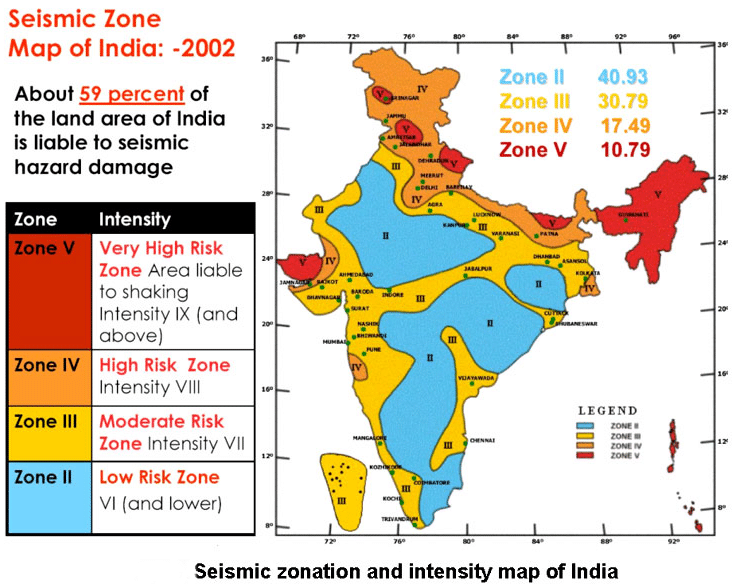 Susceptibility of Major Earthquakes:
Susceptibility of Major Earthquakes:
- Scientists are aware of identifiable seismic gaps along the Himalayan axis where the historical release of geological tension doesn’t fully account for the strain that has built up.
- For instance, the Central Himalaya has been historically deficient in earthquakes compared to other areas. So, it’s one region that can reasonably be expected to generate a large earthquake in the future.
- Note: Seismic Gap is the part of an active fault that has experienced little or no seismic activity for a long period, indicating the buildup of stresses that are useful in predicting earthquakes.
Earthquakes In/Around India:
- India has experienced several significant earthquakes over the years, here are some examples:
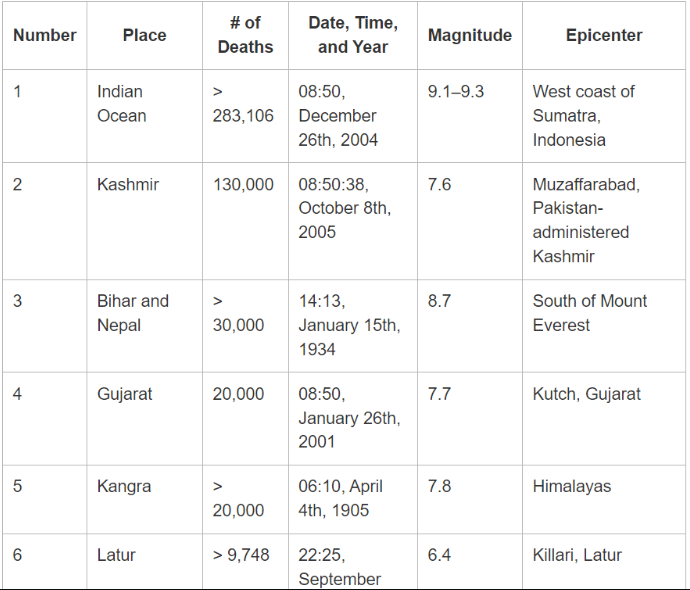
- Nepal Earthquake 2015: On April 25, 2015, a magnitude 7.8 earthquake struck Nepal. The earthquake also had a significant impact in northern India.
- Imphal Earthquake 2016: On January 4, 2016, a magnitude 6.7 earthquake struck the northeastern Indian state of Manipur, causing widespread damage.
- Uttarakhand Earthquake 2017: On February 6, 2017, a magnitude 6.7 earthquake struck the northern Indian state of Uttarakhand.
What Steps can be Taken for Earthquake Preparedness in India?
- Building Codes and Standards: India has established building codes and standards for earthquake-resistant construction.
- It is important to strictly enforce these codes and standards to ensure that new buildings are built to withstand earthquakes. This will also require regular inspections and enforcement of existing building codes.
- Retrofitting and Reinforcement: Older buildings may not meet current earthquake-resistant standards, and many of them can be retrofitted or reinforced to improve their seismic performance.
- Emergency Response Planning: Planning for emergency response is critical for minimising the impact of earthquakes. This includes developing evacuation plans, establishing emergency shelters, and training personnel on how to respond to earthquakes.
- Research and Monitoring: Investing in research and monitoring can help improve our understanding of earthquakes and their causes, and can also help to develop better methods for predicting and mitigating their impact.
- Land-Use Planning: It is important to consider the potential impacts of earthquakes when planning and developing land-use policies. This includes limiting development in areas that are prone to earthquakes and ensuring that new development is designed and constructed in a way that minimises the risk of damage.
India’s Farm Exports
Context: The agriculture sector in India has experienced buoyant growth in the past two years.
- India’s agricultural exports are poised to scale a new peak in the financial year ending March 31, 2023. But so are imports, bringing down the overall farm trade surplus.
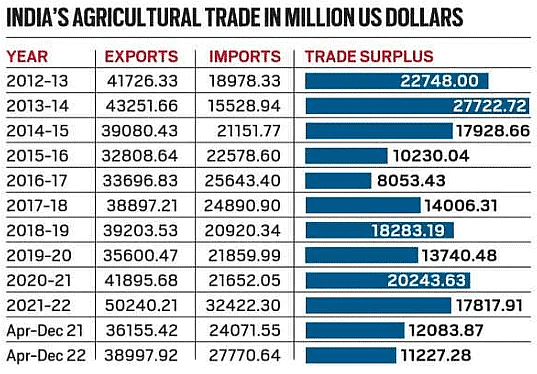
What are the Agri-Stats?
- The value of farm exports in April-December 2022 was 7.9% higher (USD 39 Billion) than the USD 36.2 bn for the corresponding period of the previous year.
- However, imports have grown 15.4% (USD 27.8 bn) in Apr-Dec 2022, over the USD 24.1 bn for Apr-Dec 2021.
- As a result, there has been a further shrinking of the surplus on the farm trade account.
- The two big contributors to India’s agri-export growth have been Rice and Sugar.
- Rice: India in 2021-22 shipped out an all-time-high 21.21 million tonnes (mt) of rice valued at USD 9.66 billion. That included 17.26 mt of non-basmati and 3.95 mt of basmati rice.
- Sugar: Sugar exports hit a record value of USD 4.60 billion in 2021-22, as against USD 2.79 billion in last fiscal. This fiscal has seen a further surge of 43.6%, from USD 2.78 billion in April-December 2021 to USD 3.99 billion in April-December 2022.
- However, exports of some big-ticket items have faltered or slowed, such as spices, wheat, buffalo meat etc.
What about the Imports?
- Vegetable Oil: According to the Solvent Extractors’ Association of India, India’s total edible oil imports rose from 13.13 mt in 2020-21 to 14.03 mt in the 2021-22 oil year (Nov-Oct), and increased further by 30.9% from 2.36 mt in Nov-Dec 2021 to 3.08 mt in Nov-Dec 2022.
- Cotton: India has turned from a net exporter to a net importer of cotton. Exports collapsed to USD 512.04 million in April-December, 2022 (from USD 1.97 billion in April-December 2021) and imports have also soared from USD 414.59 million to USD 1.32 billion for the same period.
- Cashew: During April-December 2022, imports have posted a 64.6% rise to USD 1.64 billion from USD 996.49 million in April-December 2021, even as exports of cashew products have plummeted from USD 344.61 million to USD 259.71 million for the same period.
How India’s Farm Performance is Linked to International Commodity Prices?
- The UN Food and Agriculture Organization’s (FAO) Food Price Index — having a base value of 100 for the 2014-16 period — averaged 122.5 points in 2012-13 and 119.1 points in 2013-14.
- Those were the years when India’s agri-exports were at USD 42-43 billion.
- As the index crashed to 90-95 points in 2015-16 and 2016-17, so did exports to USD 33-34 billion.
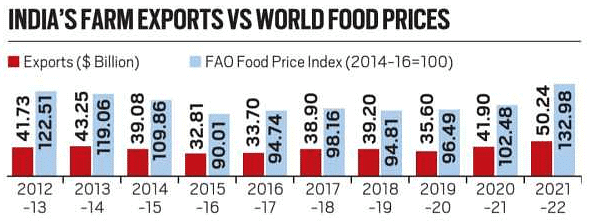
- The FAO index peaked at 159.7 points in March 2022, just after the Russian invasion of Ukraine. Since then, it has fallen every month, with the latest reading of 131.2 points for January 2023 the lowest after the 129.2 points of September 2021.
- More than a general export slowdown, it’s the growth in imports that should be cause for concern.
- Going by past correlation i.e., when the index was high, exports were high, and when it was low, exports were low. Currently, the index has been falling, which may lead to a slowdown in India's farm exports and an increase in imports.
- In the event, the focus of policymakers too, may have to shift from being pro-consumer (to the extent of banning/ restricting exports) to pro-producer (providing tariff protection against unbridled imports).
Way Forward
- Clearly, the effects of not allowing new genetic modification (GM) technologies after the first-generation Bt cotton are showing, and impacting exports as well. A proactive approach is required in edible oils as well, where planting of GM hybrid mustard has been permitted with great reluctance — and which is now a matter before the Supreme Court.
|
164 videos|800 docs|1160 tests
|
FAQs on Weekly Current Affairs (8th to 14th February 2023) Part - 2 - General Test Preparation for CUET UG - CUET Commerce
| 1. What is the purpose of the Multilateral Security Dialogue on Afghanistan? |  |
| 2. What are Primary Agricultural Credit Societies? |  |
| 3. How much is India's nuclear power capacity? |  |
| 4. What is a Glacial Lake Outburst Flood? |  |
| 5. How prepared is India for earthquakes? |  |





















